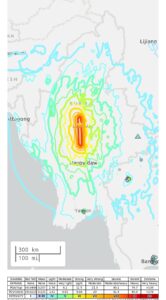Brussels – A very powerful earthquake struck Southeast Asia this morning (March 28), with a violent magnitude 7.7 tremor recorded northeast of Sagaing, in Myanmar, early this morning (Eu time). According to data released by the United States Geological Survey (USGS), the quake occurred at a depth of 10 kilometres, covering an area including central and northern Thailand and the Yunnan province in southwestern China.
The junta in Myanmar has declared a state of emergency in six regions: Sagaing, Mandalay, Magway, northeastern Shan, Naypyidaw, and Bago. Authorities also appealed to the international community for humanitarian aid to support the affected population. State of alert also in the Thai capital, Bangkok, where stores, offices, and homes have been evacuated following the powerful tremors, with eight dead so far. A 30-story skyscraper under construction has collapsed, while media report that there would still be dozens of workers might be still trapped under the rubble.

The major damage occurred in Myanmar: according to the local newspaper The Global Newlight of Myanmar, the earthquake caused the collapse of the old Sagaing Bridge and several buildings in Mandalay, Nay Pyi Taw, Pyinmana, Aungban, and Inle. Damage also included the collapse of the Dotehtawadi Bridge on the Yangon-Mandalay Expressway and portions of the Yangon-Mandalay Expressway, causing some road closures along the route. Mandalay and Naypyidaw airports were also severely damaged by the earthquake. Naypyidan Hospital is currently the arrival site for most of the injured people, where dozens of people are being helped out of the now-saturated emergency room. Burmese junta leader Min Aung Hlaing has already travelled to the site.
The victim count continues to rise, and there are, as of now, 140 ascertained victims. Among them, according to broadcaster Xinhua, ten people have died as a result of the collapse of a mosque in Mandalay, and another eight in the collapse of a building under construction in the city. An unfortunately provisional number: as the USGS points out, “There are likely to be many fatalities and extensive damage, and the disaster is widespread. There could be thousands of deaths.” The U.S. scientific agency points out that “the population of this region resides in structures vulnerable to earthquakes, although resilient structures do exist. The predominant types of vulnerable buildings are informal buildings, constructed, for example, of metal or wood, and those with unknown or miscellaneous materials.”
In solidarity with the victims, the European Commission intervened. In a post on X, Crisis Management Commissioner Hadja Lahbib said that the EU “is monitoring the situation and has activated the Copernicus earth observation tool to facilitate impact assessment.” Commission President Ursula von der Leyen expressed sympathy for the victims and their families and reaffirmed the use of satellites in aid of first responders. “We are ready to provide more support. We stand with you in full solidarity,” the president concluded.
English version by the Translation Service of WithubHeartbreaking scenes from Myanmar and Thailand after the devastating earthquake.
My thoughts are with the victims & their families.
Europe’s Copernicus satellites are already helping first responders.
We are ready to provide more support.
We stand with you in full solidarity. https://t.co/J7tX7ZJZrF
– Ursula von der Leyen (@vonderleyen) March 28, 2025




